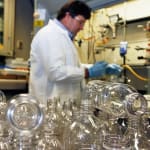 Usually, plastic bottles, PETs are recycled by mechanical technologies, and they get several other uses afterwards: carpets, sweaters, etc.
Usually, plastic bottles, PETs are recycled by mechanical technologies, and they get several other uses afterwards: carpets, sweaters, etc. They don’t ever return to their original water bottle use. It is possible to chemically recycle PETs, though, but the method has been so far very expensive and the industry doesn’t want that option.
Things are about to change, as researchers from IBM and Stanford have worked on a catalyst (a type of molecule called carbene), which can allow the manufacturers to chemically recycle used PETs and give them the same use they had before: water bottles. The catalyst was inspired by vitamin B1, says Stanford chemistry professor Robert Waymouth. The Stanford and IBM researchers guessed that a similar organic small molecule might be good at catalyzing reactions that string esters together to make long polymers.
The method presented by MIT and Stanford can chemically recycle at the temperature of only 75 °C. Since PETs are made of an organic acid and ethylene glycol, the catalyst they invented works in an ethylene glycol solution. When the cut up bottles are placed in the solution heated at the proper temperature, the catalyst causes the organic acid in the plastic to react with the ethylene glycol in the solution to make PET that has the same properties as the initial material.

It took 10 years for the scientists to figure out how to make the catalyst; it all began with IBM’s research to find ways of developing better polymers used as an insulating layer in computer chips. These layers are traditionally prepared using catalysts that contain metal. Metallic catalysts are highly active, but they’re difficult to remove once the reaction is done, leaving small impurities that can nonetheless interfere with a chip’s performance.
These metal impurities can also leach out, becoming an environmental pollutant when the chip is trashed at the end of its lifetime. “To remove that catalyst is cost-prohibitive, so we started looking for a new way to make polymers,” says James Hedrick, lead scientist at IBM’s Almaden Research Center in San Jose, CA.
As with all discoveries, the possibility of up-scaling the procedure is being investigated. “We need to see if what we discovered on the lab bench can work in big reactors,” says Waymouth. If so, the newly-discovered catalyst could enhance the recycling possibilities that the industry has today, diminishing the negative effects plastics have on the environment, during their entire existence.


